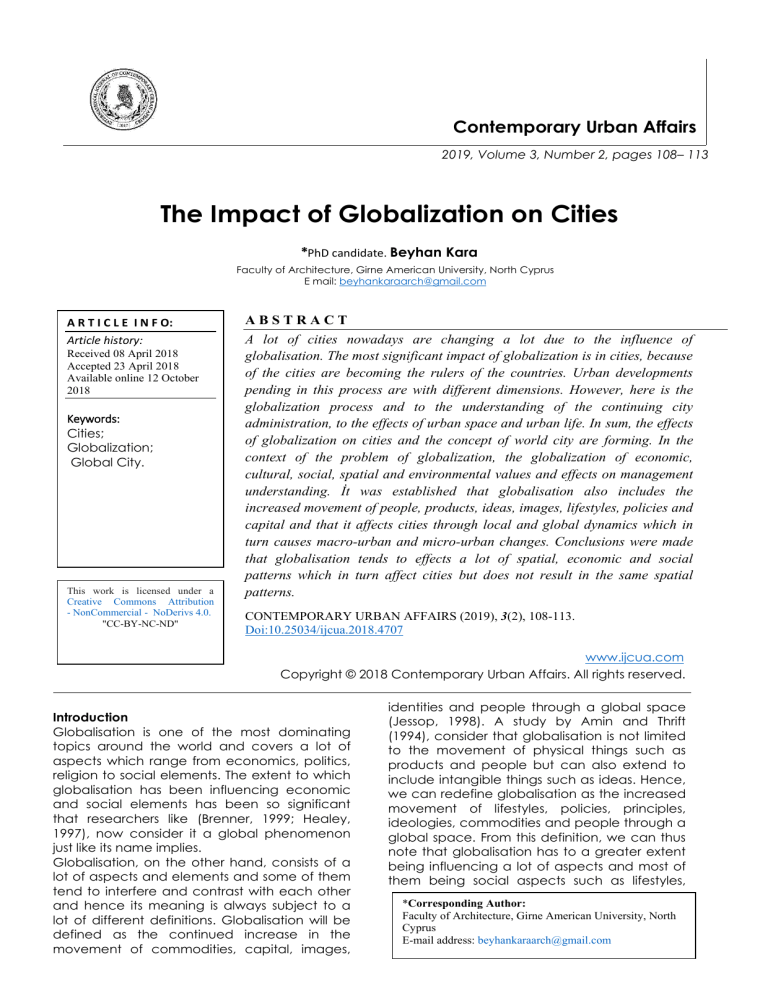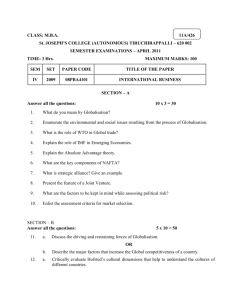
Contemporary Urban Affairs
2019, Volume 3, Number 2, pages 108– 113
The Impact of Globalization on Cities
*PhD candidate. Beyhan Kara
Faculty of Architecture, Girne American University, North Cyprus
E mail: beyhankaraarch@gmail.com
A R T I C L E I N F O:
Article history:
Received 08 April 2018
Accepted 23 April 2018
Available online 12 October
2018
Keywords:
Cities;
Globalization;
Global City.
This work is licensed under a
Creative Commons Attribution
- NonCommercial - NoDerivs 4.0.
"CC-BY-NC-ND"
ABSTRACT
A lot of cities nowadays are changing a lot due to the influence of
globalisation. The most significant impact of globalization is in cities, because
of the cities are becoming the rulers of the countries. Urban developments
pending in this process are with different dimensions. However, here is the
globalization process and to the understanding of the continuing city
administration, to the effects of urban space and urban life. In sum, the effects
of globalization on cities and the concept of world city are forming. In the
context of the problem of globalization, the globalization of economic,
cultural, social, spatial and environmental values and effects on management
understanding. İt was established that globalisation also includes the
increased movement of people, products, ideas, images, lifestyles, policies and
capital and that it affects cities through local and global dynamics which in
turn causes macro-urban and micro-urban changes. Conclusions were made
that globalisation tends to effects a lot of spatial, economic and social
patterns which in turn affect cities but does not result in the same spatial
patterns.
CONTEMPORARY URBAN AFFAIRS (2019), 3(2), 108-113.
Doi:10.25034/ijcua.2018.4707
www.ijcua.com
Copyright © 2018 Contemporary Urban Affairs. All rights reserved.
Introduction
Globalisation is one of the most dominating
topics around the world and covers a lot of
aspects which range from economics, politics,
religion to social elements. The extent to which
globalisation has been influencing economic
and social elements has been so significant
that researchers like (Brenner, 1999; Healey,
1997), now consider it a global phenomenon
just like its name implies.
Globalisation, on the other hand, consists of a
lot of aspects and elements and some of them
tend to interfere and contrast with each other
and hence its meaning is always subject to a
lot of different definitions. Globalisation will be
defined as the continued increase in the
movement of commodities, capital, images,
identities and people through a global space
(Jessop, 1998). A study by Amin and Thrift
(1994), consider that globalisation is not limited
to the movement of physical things such as
products and people but can also extend to
include intangible things such as ideas. Hence,
we can redefine globalisation as the increased
movement of lifestyles, policies, principles,
ideologies, commodities and people through a
global space. From this definition, we can thus
note that globalisation has to a greater extent
being influencing a lot of aspects and most of
them being social aspects such as lifestyles,
*Corresponding Author:
Faculty of Architecture, Girne American University, North
Cyprus
E-mail address: beyhankaraarch@gmail.com
JOURNAL OF CONTEMPORARY URBAN AFFAIRS, 3(2), 108-113 / 2019
culture, and images.
İt is also important to note that the increase in
globalisation has been caused by two
important things and these are technological
and media developments. A lot of new and
innovative technology is now being introduced
almost on an annual basis and this affects the
way people communicate or shares ideas
(Tasan & Van Weesep, 2007). İn addition, the
growth and developments of social media
channels now play an important role in
people’s lives as it now causing huge changes
in people’s tastes and preferences.
İrrespective of the causes of globalisation,
there are a lot of ideas which consider
globalisation to pose huge effects on the
society. For instance, an idea was given by
Ritzer (2004), also showed that globalisation has
huge effects on social aspects, values, norms
and beliefs as well as activities and processes
that characterise of help to identify people.
With regards to this aspect, it can thus be
noted that globalisation tends to affect the
way people stay. This can be supported by
ideas obtained from a study by Jessop and
Sum (2000), which highlighted that there is now
a huge shift in the way people are staying
especially those in the cities as a result of
globalisation. This idea shows that there is a
strong connection between globalisation
patterns and cities whether in terms of
structure, style, designs or development. This is
because changes in lifestyles, culture, tastes
and preferences as a result of globalisation
tend to affect the way cities are designed and
developed. This can simply be expressed the
way and extent to which cities are being
urbanised.
Meanwhile,efforts to study the impact of
globalisation will not be complete unless effort
is devoted to studying how it affects cities. This
is also because of ideas which have been
given which showed that globalisation does
not only affect economic elements but also
causes a change in culture, lifestyle, opinions,
beliefs, ideas, tastes and preferences (Johnston
et al., 2003).Hence, we can expect that
people’s perception towards modern western
architectural building designs to change as
well as their desire to stay in the cities. More so,
it was noted that there is a change in the way
cities are being managed as a result of an
influx of new ideas through globalisation. With
all these ideas in mind, it, therefore, shows that
there is a greater need to examine the effects
of globalisation on cities. This paper, therefore,
seeks to examine the effects of globalisation on
cities.
The Concept of Globalisation and Urban
Geography
As noted from the above explanations,
globalisation has a strong influence on urban
geography and effort was once placed by the
Urban Regional Research Centre Utrecht to
examine the effects and scope of globalisation
(Jessop & Sum, 2000). The findings showed that
ideas about globalisation have been limited in
terms of scope and that both its effects and
scope are diverse and affect a lot of things
such as urban development. This was further
supported by ideas established in a study by of
Tuna Taçan-Kok which highlighted that the
effects of globalisation are not homogenised
and have a lot of effects on spatial patterns on
the periphery of both developed and
developing
economies
(Healey,
1997).
This,however, led to two important questions
being raised, that is,
•
What is globalisation?
•
How does globalisation affect local
specialities such as cities?
From
these
two
questions,
additional
information and ideas were obtained which
showed that globalisation itself is always
changing and that it poses effects on
economic activities in cities. Hence, it can be
questioned from these ideas;
•
Whether globalisation affects spatial,
economic and social patterns?
•
İf all the places that are experiencing
globalisation have the same spatial, economic
and social patterns?
•
To what extent can we regard spatial
changes in cities as globalisation?
•
Whether certain urbanchanges can be
linked to globalisation or not and if so how?
Observations were made that all globalising
cities are increasingly becoming similar
(Hubbard & Hall, 1998). Whether the new city
features are more important than the old age
city features or not, it all depends on how
people are viewing the newly globalised cities.
Some of these aspects were narrowly covered
and outlined in the Journal of Housing and the
Built Environment in which it is highlighted that
there is a relationship that exists between urban
systems, local development and globalisation
(Bryson, et al., Eds.). As a result, globalisation
was presumed as causing positive changes in
urban systems and local development.
However, the extent to which globalisation
affects local urban systems and local
development tend to differ with the way and
manner to which global and local aspects of
globalisation are being handled or
Beyhan Kara
109
JOURNAL OF CONTEMPORARY URBAN AFFAIRS, 3(2), 108-113 / 2019
Figure 1. Conceptual aspects of globalisation, urban change and property market dynamics
approached. This implies that globalisation has
its own different global effects and the way in
which the local environment or people
respond to globalisation also influences urban
systems and local developmentis going to
change. Which implies that the greater the
level and extent to which the global economy
is globalising will also have a significant
influence on how other cities will be affected or
will globalise. On the other hand, the more
responsive
the
local
people
are
to
globalisation, the greater the level of changes
that will be seen in terms of urban systems and
local development. As a result, this paper can,
therefore, raise the following questions;
•
What is really globalisation and how
does it affect cities?
•
How do local and global forces
contribute to urban change?
•
To what extent do global processes
affect neighborhood development?
•
Why do cities that are part of regional
systems still dependent on other cities when
globalisation can make them less dependent?
•
How changes in global capital
movements affect the real estate and property
sector and in turn cause changes in cities?
•
How can urban management be
modelled to account or cater for the
globalisation of cities?
The above questions can somehow be
grouped into four elements and the obtained
elements are illustrated in a diagrammatical
form as shown in figure 1. İt can be noted that
the effects of globalisation will initially
commence on a global scale then extend to
the lower level. They also see changes starting
from the urban systems rising to affect the
urban systems which in turn affect cities at the
neighbourhood level. İt is at the neighborhood
level that we find property market dynamics.
The figure above reflects globalisation is a
multi-faceted element which affects a lot of
aspects. As noted, it affects the mobility and
circulation of capital, images, products and
people and this, in turn, causes urban change
as it begins to reflect the micro-urban change
and macro-urban change. There are also
changes in governmental structures that occur
as a result of globalisation. Once governmental
structures begin to change, urban changes
both macro and micro, as well as changes in
property market dynamics, will be inevitable.
Changes in property market dynamics usually
cause a change in reaction by property
market actors.
There are however ideas which go against
some of the implications made by figure 1 and
such ideas also agree that globalisation tends
to affects a lot of spatial, economic and social
patterns, but they tend to disagree on the idea
that globalisation does not result in the same
spatial patterns.
Efforts to examine how globalisation affects
cities can also be analysed using the
interaction of local and global dynamics as
shown in figure 2.
Beyhan Kara
110
JOURNAL OF CONTEMPORARY URBAN AFFAIRS, 3(2), 108-113 / 2019
Figure 2. The influence of the interaction between local and global dynamics of globalisation on cities. Source: Taşan-Kok
and Van weep (2007, pp. 5). Global-local interaction and its impact on cities.
Figure 2, denotes that both local and global
dynamics interact to cause changes in local
institutions. The same applies to local and
global organisations, they all pose effects on
local institutions and it is through changes in
localinstitutions that changes in cities will begin
to take place.
What is being globalised?
Different ideas can also be given on what is
being globalised. There are studies which show
that globalisation does not globalise anything
(Jessop & Sum, 2000; Johnston et al., 2003). Yet,
on the other hand, it can be noted that
globalisation affects almost anything be it
retailing or consumption (Jessop, 1998). This
can be supported by ideas established by
Ritzer (2004) which suggests that globalisation
has initiated almost similar patterns of
consumption with an increase in the creation
of non-places. As a result, there is an increase
in the number of entertainment centres, office
parks, shopping centres that are being created
as a result of globalisation. However, the ability
of other people in other cities to follow the
same patterns does not mean that a standard
or measurement or an idea that the effects of
globalisation are the same but rather serve as
an inspiration for spatial development. Though
cities may also take or assume the same
architectural style, design, scale and function,
it still remains the same that globalisation is not
causing the same effects across the globe or
on cities (Johnston et al., 2003).
Urban change: Global and Local Forces
Global forces tend to have an impact on
urban areas and such impact are due to the
following reasons;
Economic globalisation causes cities to look
more beautiful as capital funds are moved
from one nation to the other especially from
advanced cities to urban areas that may
possibly be lacking in terms of development
(Ritzer, 2004).
İncreases in global competitiveness which is
causing cities to seek new regulatory
frameworks so as to provide support to nonmarket, neo-liberal and entrepreneurial market
regimes (Tasan & Van Weesep, 2007).
Cities are a form or representation of a legal
system and their administratorstend to adopt
social, politicaleconomicand local conditions.
This is because urban development tends to
assume of following certain patterns and
hence making it difficult to have a model of a
globalised city (Tasan & Van Weesep, 2007).
Cities
are always in competition
for
international funds and efforts to lure more
funds than other cities will be reflected on how
they react and position developmental
activities so as to gain a competitive
advantage over other cities (Jessop, 1998).
However, globalization is said to increase the
subjugation of localities (cities or regions) to
global forces (Amin & Thrift, 1994).
Beyhan Kara
111
JOURNAL OF CONTEMPORARY URBAN AFFAIRS, 3(2), 108-113 / 2019
Urban Systems within The Global Network of
Cities
When it comes to the idea of globalisation,
considerations can be made that cities can
benefit positively from globalisation. This is
because cities can attain better positions in the
world by boosting the competitive edge. This is
also as a result of the idea that economic,
political and social strategies adopted and
implemented by urban governance do not
only
cause
a
change
in
economicperformance but also result in
additional economic development (Ritzer,
2004), Ritzer (2004). Efforts to ensure that cities
remain competitive require that cities possess
sound
and
effective
decision
makers,
organisations and actors. This is because the
main emphasis is to get more global capital. As
a result, municipal authorities will engage in
activities that will see cities being developed
especially to levels and standards where they
can; lure more global funds (Tasan & Van
Weesep, 2007). Such can also be a reflection
of the effects of globalisationwhich,may also
cause cities to become a global network of
each other.
Globalization and property markets
İt is also important to note that there exists a
relationship
between
globalisation
and
property markets. This can be illustrated using
ideas given by Ritzer (2004), which contend
that globalisation results in globalised cities
which have features of cities as being financial
centres and huge bearing of an urban
economy. Such is possible when barriers that
limit capital movement have been removed
hence creating a new urban space and place
for consuming, servicing, producing, working
and dwelling. More investors who are in need
of potential investment vehicles often turn to
the property market for investment (Tasan &
Van Weesep, 2007). Such can have a huge
impact on cities especially when investors from
globalised nations begin to plough more funds
into cities that are notglobalised and
developed.
Conclusions
Based on the established ideas conclusions
can, therefore, be made that globalisation
tends to affect cities and its effects on cities is
in a number of different forms. This follows ideas
which have also been given which showed
that globalisation does not only affect
economic elements but also causes a change
in culture, lifestyle, opinions, beliefs, ideas,
tastes and preferences. Conclusions can also
be made that globalisation tends to affects a
lot of spatial, economic and social patterns
which in turn affect cities. Conclusions can also
be made that though globalisation affects
cities, it, however, does not result in the same
spatial patterns. Conclusions can be made in
respect of the established questions that;
Globalisation is the continued increased in the
movement of people, products, ideas, images,
lifestyles, policies and capital and that it affects
cities through local and global dynamics which
inturn causes macro-urban and micro-urban
changes.
Changes in local and global forces contribute
to urban change through the effects they pose
on local institutions which inturn causes macro
and micro urban changes.
Cities that are part of regional systems can still
be dependent on other cities when
globalisation can make them less dependent
because they are part of a network of cities
which relies on other cities for products,
services, ideas etc.
Changes in global capital movements affect
the real estate and property sector and in turn,
cause changes in cities as investors will be
looking for investment vehicles which they can
use to make investments. The notable
investment vehicle being the property market.
Policy implications
There is greater need to take advantage of
globalisation especially in terms of people,
products, ideas, culture and capital to
positively design and develop cities in a way
that will enhance people’s standard of living
and quality of lifestyle.
Domestic or local planning authorities and
architects are strongly encouraged to adopt
international standards in the day so as to
come with developments and designs that are
of international standard and quality.
Cities or urban administrators must have good
management of public resources so that they
be entrusted with huge global capital funds.
Better management of cities is needed so as to
put an effective use of funds towards the
development of cities.
References
Amin, A., & Thrift, N. (1994). Globalization,
institutions, and regional development in
Europe. Oxford ; New York : Oxford
University
Press,
Retrieved
from:
https://researchinformation.bristol.ac.uk/en/publications/gl
obalization-institutions-and-regional-
Beyhan Kara
112
JOURNAL OF CONTEMPORARY URBAN AFFAIRS, 3(2), 108-113 / 2019
development-in-europe(5370969f-d86945b8-b92b-84db2fd95aba).html
Brenner,
N.
(1999).
Globalization
as
reterritorialization: The re-scaling of urban
governance in the European Union. Urban
Studies, 36(3), 431-451. Available at
http://citeseerx.ist.psu.edu/viewdoc/downl
oad?doi=10.1.1.483.2958&rep=rep1&type=
pdf
Bryson, N. Henry, D. Keeble, & R. Martin (Eds.)
(1999). The economic geography reader. In
K. Olds, &J. Poon, (2002). Theories and
Discourses of Economic Geography: Papers
from the Singapore Conference on
Economic Geography, December 2000.
Environment and Planning A: Economy and
Space,
34(3),
379–383.
https://doi.org/10.1068/a356
Healey,P, Khakee, K., Motte, A., & Needham, B.
(Eds.). (2006).Making strategic spatial plans:
Innovation in Europe. UCL Press Limited,
London:
ULL.
Available
at
https://epdf.tips/making-strategic-spatialplans-innovation-in-europe-umeauniversity-sweden-alain.html
Hubbard, P., & Hall, T. (1998). The
entrepreneurial
city:
Geographies
of
politics, regime and representation. In F.
Wu.
(2003).
The
(Post-)
Socialist
Entrepreneurial City as a State Project:
Shanghai’s Reglobalisation in Question.
Urban
Studies,
40(9),
1673–1698.
https://doi.org/10.1080/00420980320001065
55
Jessop, B. (1998). The narrative of enterprise
and the enterprise of narrative: Place
marketing and the entrepreneurial city.
Retrieved
from:
https://www.researchgate.net/publication/
312608606_The_enterprise_of_narrative_and
_the_narrative_of_enterprise_place_marketi
ng_and_the_entrepreneurial_city
Jessop, B., & Sum, N. L. (2000), The
entrepreneurial city in action: Hong Kong's
emerging strategies in and for (inter-) urban
competition. Urban Studies, 37(12), 22872313.
Retrieved
from:
http://www.lancaster.ac.uk/fass/resources/
sociology-online-papers/papers/jessopsum-USE-2000a.pdf
Johnston, R. J., Gregory, D., Pratt, G., & Watts,
M. (2003). The dictionary of human
geography. Maiden: Blackwell. Retrieved
from:
http://www.univpgripalembang.ac.id/perpusfkip/Perpustakaan/Geography/Kamus%20
Geografi/Kamus%20Geografi%20Manusia.p
df
Ritzer, G.& Ryan, M. (2007). The Globalization of
Nothing. SAIS Review. 23(2), 189-200.
https://doi.org/10.1353/sais.2003.0053
Steger, M. B. (Ed.).(2010). Globalization: The
Greatest Hits: A Global Studies Reader (pp.
71-84). In R. J. Sutcliffe (2015). Globalisation
and subjective globalisation (pp. 1-42).
Retrieved
from:
https://www.academia.edu/31251394/Sutcl
iffe_Globalization_Subjective_Globalization.
pdf
Taşan-Kok, T., & Van weesep, J. (2007). Globallocal interaction and its impact on cities.
Journal of Housing and the Built
Environment, 22(1), 1-11. Retrieved from:
http://www.jstor.org/stable/41107365
Beyhan Kara
113



